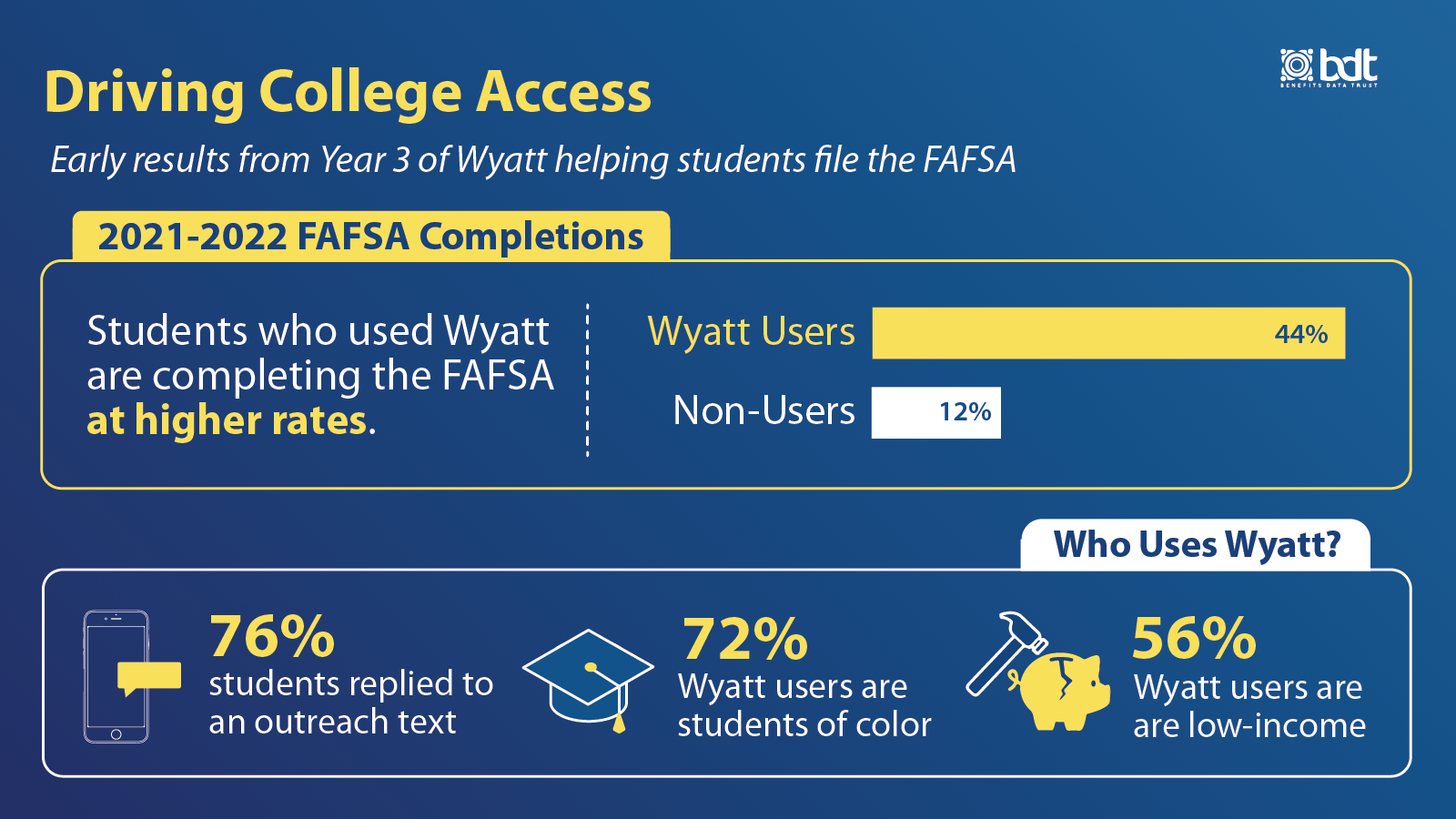Enter Benefits Data Trust (BDT), which builds innovative solutions to streamline and help individuals navigate complicated benefit application processes. In 2019, BDT launched Wyatt℠, a text-message-based chatbot that provides college-bound students with free, personalized assistance to complete the FAFSA. Research has shown that personalized assistance improves filing rates, but this assistance has proved difficult to scale. That’s where Wyatt can help.
Wyatt launched for a third year in October 2021 and is available to high school seniors participating in the College Board Opportunity Scholarships through February 2022.

To learn more about what it took to build an innovative tool like Wyatt, we sat down with Julia Kosov, Outreach Analytics Manager and Jessica Westbrook, Content Analyst to hear from them about their work to create the chatbot.
-
Building a chatbot sounds complicated, to say the least. What were the first steps you took to begin working on Wyatt? What tools and technology go into creating a chatbot?
- Julia: Lots of research and quickly learning new technologies! We leveraged our existing relationship with Twilio — a customer engagement platform we were already using for our outreach texting — and decided to build Wyatt using “Autopilot”, Twilio’s out of the box chatbot product. From there, we had two main teams – one that focused on “plugging in all the wires” so to speak, and the other that focused on how Wyatt would talk to students.
-
Wyatt is an AI chatbot – I know AI stands for artificial intelligence, but what does that really mean?
- Julia: In short, AI refers to the ability of a computer to think and behave like a human. More specifically, we’re working with a branch of AI called “Natural Language Processing”. That means that a computer can understand what a student is asking and correctly answer them without any intervention from us.
-
One student who used Wyatt said, “I almost couldn’t tell that you were a robot for a bit…” How is Wyatt able to respond and answer questions so effortlessly?
- Julia: Lots and lots of careful monitoring and training went into the creation process! We taught Wyatt every single way we thought a student could possibly say “I don’t know how to log in” or “My parents are divorced – whose income do I report?”. Once Wyatt launched, we kept a close eye on how students were interacting with it and used those interactions to continuously improve Wyatt’s algorithm. Wyatt is always learning!
-
What was the testing and training process like to ensure that Wyatt was ready before it was available to students?
- Jess: We launched Wyatt for the first time in 2019, and we made sure to have FAFSA experts help inform our response set and test the bot, including a group of former financial aid administrators and former counselors at the College Board. The first year served as a pilot with a small group of students interacting with the bot. This allowed our team to really get our footing and better understand student inquiries, training practices, and bot accuracy.
-
What is your favorite thing about seeing Wyatt in action?
- Jess: I love seeing how the students interact with Wyatt. High school seniors are extremely witty, and they’re not afraid to tell Wyatt if they need a different answer — and Wyatt can handle it. But much more than that, seeing students thank Wyatt for help or sharing that having this resource made the process much easier is extremely heartwarming. To see Wyatt making differences in FAFSA completions and ease of completions is really gratifying.
-
If there were no time, budget, or resource restrictions, what’s one thing you would want to improve or change about the tool?
- Jess: I’d love to see Wyatt learn more about the student and remember prior conversations to make the experience more seamless and personalized.
-
How did you come up with the name Wyatt for the chatbot?
- Julia: Our wonderful communications team took the lead on this! There were large brainstorming sessions to come up with short and sweet names that were punchy or even punny! We sourced feedback internally and the College Board sent out a survey to students to get their input on our top five names and Wyatt was born! Wyatt means “leader” or “guide”, which we thought was an appropriate name for a tool that guides students through the complicated process of applying for financial aid.
As Wyatt continues to assist students nationwide, we look forward to studying its impact and exploring how Wyatt can evolve to help even more students and potentially guide them through a broader set of topics related to paying for college.

Julia Kosov is the Outreach Analytics Manager at BDT and has been with the organization for three years. Julia works with the data, product, and implementation teams to develop scalable outreach solutions. In her spare time, she likes to read, play games, and spend time with her cat.
Jessica Westbrook is the Content Analyst at BDT and has been with the organization for two years. Jessica researches, tests, and crafts the outreach materials BDT sends to clients to encourage them to apply for benefits they’re likely eligible for. In her free time, she enjoys transforming her fixer upper house through DIY projects and relaxing with her dog.
